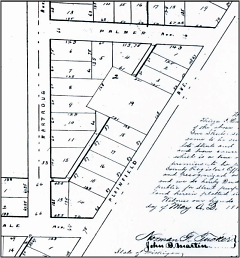By: Pete Tabberer
Fire was a constant danger to city dwellers of the 19th and early 20th centuries. Buildings were of primarily lumber construction, had wooden shingle roofs and were often heated by coal. Grand Rapids had it's share of devastating fires, such as in July of 1873, when strong winds and dry weather fueled a blaze that eventually burned nearly 15 blocks of the City along Bridge Street.
Although Creston was spared from catastrophes of this magnitude, there were still many fires in the neighborhood. In the early days of the 20th century we lost two well known landmarks to fire.
The Wartrous House
In 1862 a wealthy lumberman named Henry Wartrous decided to move his family out of the city. He bought land on the west side of Plainfield Avenue and built a large, three story house between what would eventually become Dale and Palmer Streets (this was, at the time, well north of the city limits). Henry died in 1882 and the land, including the house, was platted and sold.
In February of 1905, Melvin Willetts and his family were living in the house when a fire started in a chimney. The fire quickly spread to the roof and the neighbors called the fire department. It had snowed recently and as a result the fire department was slow arriving. That, combined with poor water pressure, prevented them from controlling the fire and the house burned to the ground.
Although the Wartrous house was considered “one of the landmarks of the North End,” (Grand Rapids Press, February 14, 1905) no photos or drawings of it are known to exist. If any readers know of any, please let us know.
St. John's Home
In the late 1800s epidemics of typhus, scarlet fever, and cholera swept through West Michigan, leaving behind a large population of orphans. The local catholic community, led by Bishop Henry Richter, took it upon themselves to save these children from a life of poverty and poor health. A wealthy lumberman named John Clancy bequeathed $60,000 for an orphanage. In 1888 five acres at the corner of Leonard and Lafayette were purchased and the first portion of St. John's Orphan Asylum opened a year later.
In November of 1911, just as the Dominican sisters and around 20 children in their care were sitting down for supper, a fire broke out in the southwest wing of the building. All the children and the sisters escaped unharmed, but the building was not as lucky. By the time firefighters were able to stop the blaze, most of the wing was lost.
It was initially reported that the fire began when a little girl dropped a burning scrap of paper while trying to light a gas lamp. The sisters came to the girl’s defense, and later reports clarified that the fire was probably not started by a child, but most likely began, like the Wartrous house, in a chimney.
The building was rebuilt, though the orphanage soon moved to a smaller location. The four story “castle” on Leonard sat empty for many years and was eventually torn down. St. John's Home is currently located on Knapp Street and continues to do great work helping the less fortunate children of our community.
The Rapidian, a program of the 501(c)3 nonprofit Community Media Center, relies on the community’s support to help cover the cost of training reporters and publishing content.
We need your help.
If each of our readers and content creators who values this community platform help support its creation and maintenance, The Rapidian can continue to educate and facilitate a conversation around issues for years to come.
Please support The Rapidian and make a contribution today.

